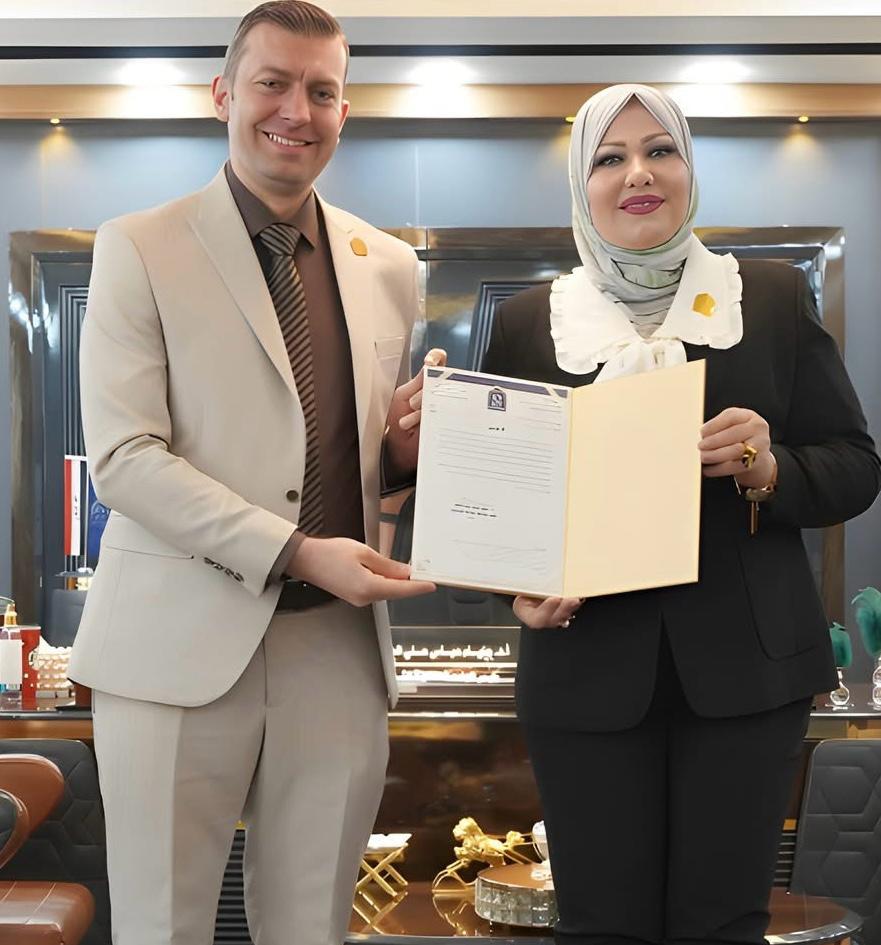
Omar Ibrahim Dallal bashi
Research InterestsRobotic and Automations Engineering
Computer and Embedded Systems Engineering
Artificial Intelligence AI
Drones
Deep Learning
Artificial Neural Networks ANN
Machine Learning
| Gender | MALE |
|---|---|
| Place of Work | Technical Engineering College for Computer and AI / Mosul |
| Position | Dean of the Technical Engineering College for Computer and AI |
| Qualification | Ph.D |
| Speciality | computer and embedded systems engineering |
| omardallalbashi@ntu.edu.iq | |
| Phone | +9647738501277 |
| Address | Mosul, Nineveh, Mosul, Iraq |

Dr. Omar I. Dallal Bashi received his Technical B.Eng. and M.Eng. degrees in Computer Engineering Technology from the Technical Engineering College of Mosul, Northern Technical University, Iraq, in 2009 and 2012, respectively. He earned his Ph.D. in 2018 from Universiti Putra Malaysia (UPM), field of Computer and Embedded Systems Engineering specializing in Robotics, and Automation Engineering.
He is currently Assistant Professor and Dean of the Technical Engineering College for Computer and Artificial Intelligence at Northern Technical University, Iraq.
He is the author of more than 15 articles and his research interests include Computer and Embedded Systems Engineering, Autonomous Drones, Artificial Intelligence, Internet of Things (IoT) Applications, Robotics, and Automation Engineering. He also holds a patent in his field of expertise.
1 +
Patent title is: "Sensing System Using Quadcopter for Risky Mission Application".Universiti Puta Malaysia (UPM).
Skills
Computer and Embedded Systems Engineering (80%)
Robotics, and Automation Engineering (85%)
Drones UAV (88%)
Deep Learning and Neural Networks (77%)
Internet of Things (IoT) Applications (75%)
Artificial Intelligence (77%)
Academic Qualification
Bachelor’s Degree
Sep 1, 2005 - Sep 1, 2009Bachelor’s Degree: Computer Engineering Techniques from the Technical Education Authority in Iraq, obtained in 2009.
Master’s Degree
Sep 1, 2009 - Jan 16, 2012Master’s Degree: Computer Engineering Techniques from the Technical Education Authority in Iraq, completed in 2012.
PhD
Jul 1, 2016 - Jul 1, 2019Doctorate: Computer Engineering and Embedded Systems from Universiti Putra Malaysia (UPM), awarded in 2019.
Working Experience
Computer Center Manager [Mosul Agricultural Technical College]
Nov 12, 2012 - Dec 20, 2015Agricultural Technical College Administration [Alternative Site in Dohuk]
Feb 5, 2015 - Mar 15, 2016Head of the Technology Incubator Division [Scientific Affairs Department / Presidency of the Northern Technical University]
Dec 9, 2018 - Nov 13, 2019Head of the Students Abroad Division [Department of Scholarships and Cultural Relations / Presidency of the Northern Technical University]
Nov 13, 2019 - Dec 30, 2019Head of the Scientific Research Division [Scientific Affairs Department / Presidency of the Northern Technical University]
Dec 30, 2019 - Sep 1, 2020Deputy Dean / Scientific and student afferce [Mosul Agricultural Technical College]
Sep 1, 2020 - Sep 1, 2023Assistant Dean /Scientific and student affairs [Mosul Technical Medical Institute]
Sep 1, 2023 - Sep 1, 2024Dean [Technical Engineering College for Computer and AI]
Jul 25, 2024 - PresentAdministrations of all the college matters
Publications
Detecting and tracking a road-drivable area with three-dimensional point clouds and IoT for autonomous applications
Sep 5, 2024Journal Service Oriented Computing and Applications
publisher Springer London
DOI http://dx.doi.org/10.1007/s11761-024-00399-7
Issue 18
Volume 4
This work presents a Light Detection and Ranging (LiDAR)-based point cloud method for detecting and tracking road edges. Initially, this work explores the progress in detecting road curb issues. A dataset (called PandaSet) with a Pandar64 sensor to capture different city scenes is used. LiDAR point cloud, as part of an IoT ecosystem, detects the road curb and requires distinguishing the right and left road curbs with regard to the ego car. The curb point’s features use Random Sample Consensus (RANSAC)-based polynomial quadratic approximation to obtain the prospect curb points to eliminate false positive ones. Through extensive experiments, we demonstrate the effectiveness and reliability of our method under various traffic and environmental conditions. Our results showcase a maximum drift of 1.62 m for left curb points and 0.87 m for right curb points, highlighting the superior accuracy and stability of our approach. This LiDAR-based curb detection framework paves the way for enhanced lane recognition and path planning in autonomous driving applications.
Trajectory optimization to minimize fuel usage for positioning guide by a nonlinear model predictive control for underwater robots
May 15, 2024Journal Ocean Engineering
publisher Elsevier Ltd
DOI 10.1016/j.oceaneng.2024.117271
Volume 300
Robotics uses model predictive control (MPC) methods frequently because they ensure viability and enable the computation of revised trajectories while the robot is in motion. Nonlinear MPC-based trajectory tracking with or without obstacle avoidance has been widely discussed priory, but there is no discussion has been made on fuel minimization. This work develops a model to obtain the optimal trajectory to move a manipulator between two locations with the lowest amount of fuel rate through a data-driven nonlinear MPC approach with an extended Kalman filter. The study showcases both first-principles and neural network approaches for modeling the robot's dynamics, highlighting the trade-offs between accuracy and computational cost. This model guides the robot to follow the best possible path in closed-loop design. We assume that there are four physical thrusts of a range of 0–1 in the robot to achieve the same manage freedom. The key performance metrics were 8.39 units for planned fuel consumption, 11.99 units for closed-loop, and 16.867 units for the neural network architecture. The simulation result of the closed-loop performance reached the chosen place with a 12% more fuel expense compared to the scheduled optimal route. Therefore, for future MPC implementation, this work explores the neural state space network as an alternative potential to the first-principles models.
Maximizing Solar Energy Utilization and Controlling Electrical Consumption in Domestic Water Heaters by Integrating with Aluminum Reflector
Mar 24, 2024Journal Measurement
publisher Elsevier
DOI http://dx.doi.org/10.1016/j.measurement.2024.114558
Volume 230
Environmental concerns and rising in energy costs require innovative solutions for household water heating. This work presents an innovative strategy for an evacuated tube-based electric/solar water heater (ESWH) incorporated with an aluminum reflector, which significantly reduces dependence on grid electricity. The whole area of the solar collector is about 2 m2, 100 liters of storage each, and the rated power of the electric heater is 3 kW. Compared to existing ESWHs, the developed system achieves a significant 15.4% enhancement in annual energy consumption over hybrid models and a staggering 46.2% reduction compared to conventional electric heaters. The key improvement lies in the integration of an aluminum reflector beneath the evacuated tubes. This simple yet effective modification demonstrably enhances solar energy capture, leading to substantial grid energy savings. Our research thoroughly evaluated the system in Iraq-Baghdad's climatic conditions. Three identical water heating systems operated simultaneously under varying configurations: solar-only, electric-only, ESWH without reflector, and ESWH with reflector. A full test process relating four operation scenarios across a full day provided thorough insights into the energy consumption profile and the system's performance. The findings show the significant potential of the proposed water heater design to contribute to environmental sustainability, energy security, and reduced house energy bills. This study covers the way for wider adoption of eco-friendly and cost-effective solar water heating solutions.
Lung disease recognition methods using audio-based analysis with machine learning
Feb 29, 2024Journal Heliyon
publisher Elsevier
DOI http://dx.doi.org/10.1016/j.heliyon.2024.e26218
Issue 4
Volume 10
The use of computer-based automated approaches and improvements in lung sound recording techniques have made lung sound-based diagnostics even better and devoid of subjectivity errors. Using a computer to evaluate lung sound features more thoroughly with the use of analyzing changes in lung sound behavior, recording measurements, suppressing the presence of noise contaminations, and graphical representations are all made possible by computer-based lung sound analysis. This paper starts with a discussion of the need for this research area, providing an overview of the field and the motivations behind it. Following that, it details the survey methodology used in this work. It presents a discussion on the elements of sound-based lung disease classification using machine learning algorithms. This includes commonly prior considered datasets, feature extraction techniques, pre-processing methods, artifact removal methods, lung-heart sound separation, deep learning algorithms, and wavelet transform of lung audio signals. The study introduces studies that review lung screening including a summary table of these references and discusses the literature gaps in the existing studies. It is concluded that the use of sound-based machine learning in the classification of respiratory diseases has promising results. While we believe this material will prove valuable to physicians and researchers exploring sound-signal-based machine learning, large-scale investigations remain essential to solidify the findings and foster wider adoption within the medical community.
Developing a model for unmanned aerial vehicle with fixed-wing using 3D-map exploring rapidly random tree technique
Feb 1, 2024Journal Bulletin of Electrical Engineering and Informatics
publisher Institute of Advanced Engineering and Science (IAES)
DOI http://dx.doi.org/10.11591/eei.v13i1.5305
Issue 13
Volume 1
While the motion planning algorithms consider the obstacles that were known in the map, it is possible to use obstacle avoidance algorithms to take over and send commands to theunmanned aerial vehicle (UAV), when there is an unknown obstacle on the way. The rapidly random tree (RRT) algorithm is used to plan paths for a quad-copter or a fixed-wing UAV. This work develops a model for UAV with fixed-wing using a 3D map exploring the RRT technique. The first step is to obtain a 3D occupancy map from the map data stored in the UAV city to provide a map with some pre-generated obstacles. The contribution of this work is to use RRT planning for 3D state space, where the motion segment or motion primitive connecting the two consecutive states should be defined in a 3D space while satisfying the motion constraints of a UAV. The simulation includes setting up a 3D map, providing the starting and destination pose, planning a way using RRT and 3D Dubins moving primitives, smoothing the acquired trajectory, and simulating the UAV flight. The results obtained demonstrate that the smoothed-generated waypoints significantly improved tracking in general with shorter paths.
Threat detection model for WLAN of simulated data using deep convolutional neural network
Oct 23, 2023Journal Applied Sciences
publisher MDPI
DOI http://dx.doi.org/10.3390/app132011592
Issue 20
Volume 13
Security identification solutions against WLAN network attacks according to straightforward digital detectors, such as SSID, IP addresses, and MAC addresses, are not efficient in identifying such hacking or router impersonation. These detectors can be simply mocked. Therefore, a further protected key uses new information by combining these simple digital identifiers with an RF signature of the radio link. In this work, a design of a convolutional neural network (CNN) based on fingerprinting radio frequency (RF) is developed with computer-generated data. The developed CNN is trained with beacon frames of a wireless local area network (WLAN) that is simulated as a result of identified and unidentified router nodes of fingerprinting RF. The proposed CNN is able to detect router impersonators by comparing the data pair of the MAC address and RF signature of the received signal from the known and unknown routers. ADAM optimizer, which is the extended version of stochastic gradient descent, has been used with a developed deep learning convolutional neural network containing three fully connected and two convolutional layers. According to the training progress graphic, the network converges to around 100% accuracy within the first epoch, which indicates that the developed architecture was efficient in detecting router impersonations.
Developing of Object Detection From Point Clouds of a 3D Dataset by Point-Pillars Neural Network
May 1, 2023Journal Eastern-European Journal of Enterprise Technologies
publisher Technology Center
DOI http://dx.doi.org/10.15587/1729-4061.2023.275155
Issue 9
Volume 2
Deep learning algorithms are able to automatically handle point clouds over a broad range of 3D imaging implementations. They have applications in advanced driver assistance systems, perception and robot navigation, scene classification, surveillance, stereo vision, and depth estimation. According to prior studies, the detection of objects from point clouds of a 3D dataset with acceptable accuracy is still a challenging task. The Point-Pillars technique is used in this work to detect a 3D object employing 2D convolutional neural network (CNN) layers. Point-Pillars architecture includes a learnable encoder to use Point-Nets for learning a demonstration of point clouds structured with vertical columns (pillars). The Point-Pillars architecture operates a 2D CNN to decode the predictions, create network estimations, and create 3D envelop boxes for various object labels like pedestrians, trucks, and cars. This study aims to detect objects from point clouds of a 3D dataset by Point-Pillars neural network architecture that makes it possible to detect a 3D object by means of 2D convolutional neural network (CNN) layers. The method includes producing a sparse pseudo-image from a point cloud using a feature encoder, using a 2D convolution backbone to process the pseudo-image into high-level, and using detection heads to regress and detect 3D bounding boxes. This work utilizes an augmentation for ground truth data as well as additional augmentations of global data methods to include further diversity in the data training and associating packs. The obtained results demonstrated that the average orientation similarity (AOS) and average precision (AP …
Autonomous Quadcopter Altitude for Measuring Risky Gases in Hazard Area
Jul 4, 2018Journal Journal of Telecommunication, Electronic and Computer Engineering (JTEC)
publisher Universiti Teknikal Malaysia Melaka
DOI https://jtec.utem.edu.my/jtec/article/view/4345
Issue 2-5
Volume 10
The increased awareness of environmental monitoring has led to the development platforms for measuring gases concentration in the risk environment. In this paper, we focused on the altitude of quadcopter flying, not to be random but will be at a certain height depending on the application and the area of implementation for a quadcopter robot. A practical implementation is recorded to know the suitable height of flying. The quadcopter is also developed to fly manually with automatic height adjustment in order to measure gas concentration reliably.
Unmanned Aerial Vehicle Quadcopter: A Review
Jan 12, 2017Journal Journal of Computational and Theoretical Nanoscience
publisher American Scientific Publishers
DOI https://doi.org/10.1166/jctn.2017.7049
Issue 12
Volume 14
Aerial vehicles of the multicopter type are vertical take-off and landing (VTOL) vehicles, which have various civil and military applications. Unmanned aerial vehicles (UAVs) are a prolific category of robotics in which additional research is required. The objective of this work is to comprehensively review the area of UAV multicopters, with a focus on quadcopter types, with respect to information summarized from 123 published research works, which have been divided into primary sections for consideration. This paper describes the types of unmanned vehicles, the quadcopter flying mechanism, quadcopter control techniques, propeller modeling, multicopter control boards, multicopter sensors and the various practical applications of multicopters. Finally, we suggest a quadcopter application that has not previously been described in the related literature, and we discuss the searching pattern used when flying such a robot.
Face Recognition Based on PCA, LBP and SVM Techniques
Mar 1, 2015Journal Engineering and Technology Journal
publisher University of Technology
DOI https://doi.org/10.30684/etj.33.3B.2
Issue 3
Volume B
Although many of methods have accomplished good success in face recognition systems, but most of them are unable to achieve recognition by using a single sample per person. In this paper, a combination of three techniques represented by local binary pattern (LBP), principal component analysis (PCA) and support vector machine (SVM) is used to present face recognition system has the ability to recognize face depending on Single Sample per Person only. The LBP and PCA are applied to extract the important features as well as reduce the dimension of the image face while the SVM is applied to classify these features according to the classes that belong to its. The proposed approach was evaluated on Yale database and the experimental results showed distinct improvement of the proposed method compared with traditional PCA based SVM classifier.
A Novel Control System for Robotics Devices
Jun 15, 2011Journal Journal of Theoretical & Applied Information Technology
publisher Journal of Theoretical & Applied Information Technology
Issue 1
Volume 28
It is difficult to find an autonomous robot capable of performing certain services in a real environment. One advantage of a robot is its ability to accomplish many of the tasks entrusted to him with high efficiency compared to that of humans. This paper aims to design and implement a robot system which has the ability to route traffic through a specific route and move with discretion through a place in so many forms, classified and put in place every time. A field programmable analog array (FPAA) technology has been used in building the proportional-integral (PI) controller system on the route of the robot in addition to the use of this technology in the programming the movement of robotic arm used to pick up the required objects. The proposed robot system underwent many tests, which showed the possibility of movement and it completed the required tasks with high accuracy according to the path planned..
Conferences
IoT Based UAV Platform for Far Distance control system
Jun 23, 2020 - Jun 28, 2020Publisher 1st International Multi-Disciplinary Conference Theme: Sustainable Development and Smart Planning, IMDC-SDSP
DOI http://dx.doi.org/10.4108/eai.28-6-2020.2297949
Country Turkey
Location Antalya
Quadcopter sensing system for risky area
Aug 23, 2017 - Aug 25, 2017Publisher IEEE Regional Symposium on Micro and Nanoelectronics (RSM)
Country Malaysia
Location Batu Ferringhi
Pattern investigation for landfill of methane gas concentration measurement
Sep 25, 2016 - Sep 27, 2016Publisher 2016 2nd IEEE International Symposium on Robotics and Manufacturing Automation (ROMA)
Country Malaysia
Location Ipoh












